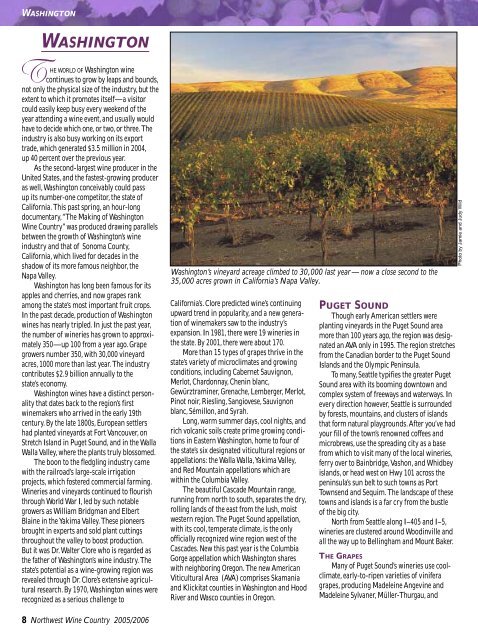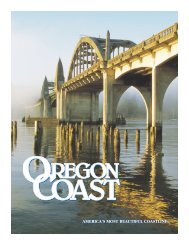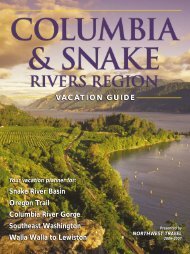Create successful ePaper yourself
Turn your PDF publications into a flip-book with our unique Google optimized e-Paper software.
WASHINGTON<br />
WASHINGTON<br />
T<br />
HE WORLD OF Washington wine<br />
continues to grow by leaps and bounds,<br />
not only the physical size of the industry, but the<br />
extent to which it promotes itself—a visitor<br />
could easily keep busy every weekend of the<br />
year attending a wine event, and usually would<br />
have to decide which one, or two, or three. The<br />
industry is also busy working on its export<br />
trade, which generated $3.5 million in 2004,<br />
up 40 percent over the previous year.<br />
As the second-largest wine producer in the<br />
United States, and the fastest-growing producer<br />
as well, Washington conceivably could pass<br />
up its number-one competitor, the state of<br />
California. This past spring, an hour-long<br />
documentary,“The Making of Washington<br />
<strong>Wine</strong> Country” was produced drawing parallels<br />
between the growth of Washington’s wine<br />
industry and that of Sonoma County,<br />
California, which lived for decades in the<br />
shadow of its more famous neighbor, the<br />
Napa Valley.<br />
Washington has long been famous for its<br />
apples and cherries, and now grapes rank<br />
among the state’s most important fruit crops.<br />
In the past decade, production of Washington<br />
wines has nearly tripled. In just the past year,<br />
the number of wineries has grown to approximately<br />
350—up 100 from a year ago. Grape<br />
growers number 350, with 30,000 vineyard<br />
acres, 1000 more than last year. The industry<br />
contributes $2.9 billion annually to the<br />
state’s economy.<br />
Washington wines have a distinct personality<br />
that dates back to the region’s first<br />
winemakers who arrived in the early 19th<br />
century. By the late 1800s, European settlers<br />
had planted vineyards at Fort Vancouver, on<br />
Stretch Island in Puget Sound, and in the Walla<br />
Walla Valley, where the plants truly blossomed.<br />
The boon to the fledgling industry came<br />
with the railroad’s large-scale irrigation<br />
projects, which fostered commercial farming.<br />
<strong>Wine</strong>ries and vineyards continued to flourish<br />
through World War I, led by such notable<br />
growers as William Bridgman and Elbert<br />
Blaine in the Yakima Valley. These pioneers<br />
brought in experts and sold plant cuttings<br />
throughout the valley to boost production.<br />
But it was Dr. Walter Clore who is regarded as<br />
the father of Washington’s wine industry. The<br />
state’s potential as a wine-growing region was<br />
revealed through Dr. Clore’s extensive agricultural<br />
research. By 1970, Washington wines were<br />
recognized as a serious challenge to<br />
Washington’s vineyard acreage climbed to 30,000 last year— now a close second to the<br />
35,000 acres grown in California’s Napa Valley.<br />
California’s. Clore predicted wine’s continuing<br />
upward trend in popularity, and a new generation<br />
of winemakers saw to the industry’s<br />
expansion. In 1981, there were 19 wineries in<br />
the state. By 2001, there were about 170.<br />
More than 15 types of grapes thrive in the<br />
state’s variety of microclimates and growing<br />
conditions, including Cabernet Sauvignon,<br />
Merlot, Chardonnay, Chenin blanc,<br />
Gewürztraminer, Grenache, Lemberger, Merlot,<br />
Pinot noir, Riesling, Sangiovese, Sauvignon<br />
blanc, Sémillon, and Syrah.<br />
Long, warm summer days, cool nights, and<br />
rich volcanic soils create prime growing conditions<br />
in Eastern Washington, home to four of<br />
the state’s six designated viticultural regions or<br />
appellations: the Walla Walla,Yakima Valley,<br />
and Red Mountain appellations which are<br />
within the Columbia Valley.<br />
The beautiful Cascade Mountain range,<br />
running from north to south, separates the dry,<br />
rolling lands of the east from the lush, moist<br />
western region. The Puget Sound appellation,<br />
with its cool, temperate climate, is the only<br />
officially recognized wine region west of the<br />
Cascades. New this past year is the Columbia<br />
Gorge appellation which Washington shares<br />
with neighboring Oregon. The new American<br />
Viticultural Area (AVA) comprises Skamania<br />
and Klickitat counties in Washington and Hood<br />
River and Wasco counties in Oregon.<br />
PUGET SOUND<br />
Though early American settlers were<br />
planting vineyards in the Puget Sound area<br />
more than 100 years ago, the region was designated<br />
an AVA only in 1995. The region stretches<br />
from the Canadian border to the Puget Sound<br />
Islands and the Olympic Peninsula.<br />
To many, Seattle typifies the greater Puget<br />
Sound area with its booming downtown and<br />
complex system of freeways and waterways. In<br />
every direction however, Seattle is surrounded<br />
by forests, mountains, and clusters of islands<br />
that form natural playgrounds. After you’ve had<br />
your fill of the town’s renowned coffees and<br />
microbrews, use the spreading city as a base<br />
from which to visit many of the local wineries,<br />
ferry over to Bainbridge,Vashon, and Whidbey<br />
islands, or head west on Hwy 101 across the<br />
peninsula’s sun belt to such towns as Port<br />
Townsend and Sequim. The landscape of these<br />
towns and islands is a far cry from the bustle<br />
of the big city.<br />
North from Seattle along I–405 and I–5,<br />
wineries are clustered around Woodinville and<br />
all the way up to Bellingham and Mount Baker.<br />
THE GRAPES<br />
Many of Puget Sound’s wineries use coolclimate,<br />
early-to-ripen varieties of vinifera<br />
grapes, producing Madeleine Angevine and<br />
Madeleine Sylvaner, Müller-Thurgau, and<br />
Photo by Jamie and Judy Wild<br />
8 Northwest <strong>Wine</strong> Country <strong>2005</strong>/2006




